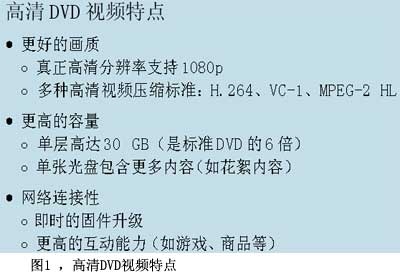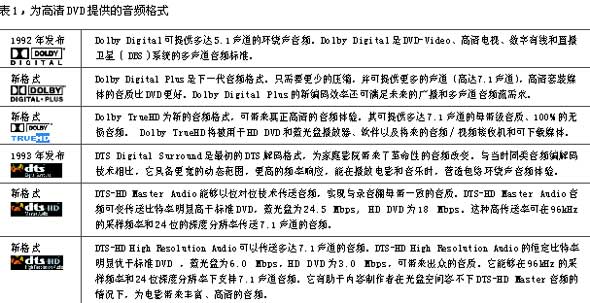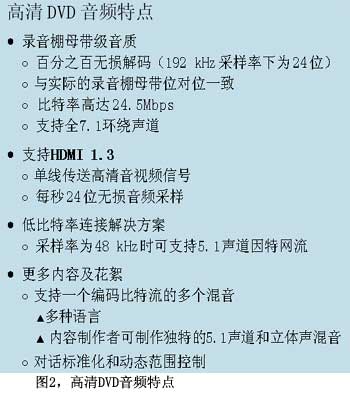The advent of next-generation HD DVD players based on Blu-ray Disc and HD DVD HD formats has created greater challenges for original equipment manufacturers (OEMs) in design complexity. While high-definition video has always received much attention, the new audio format of the HD DVD standard is a bigger challenge for OEMs who want to enter the fast-growing consumer market.
This article refers to the address: http://

Current system-on-chip (SoC) processors do not adequately address the emerging loss reduction (Dolby Digital Plus and DTS-HD High Resolution) and lossless compression (Dolby TrueHD and DTS-HD Master Audio) audio codec formats because of these new audio Formats require higher bit rates, greater storage space, higher sample rates, and better connectivity.
To accommodate and meet the format requirements for decoding multiple audio algorithms, OEMs need a single-chip solution that reduces design complexity while balancing cost, quality, and time-to-market.
HD DVD overview
Type "HD DVD" into any Internet search engine and you'll get a series of comments, blogs, and discussions about the Blu-ray and HD DVD formats. But it must be clearly stated that this article is not aimed at the ongoing debate, but on the next generation of audio algorithms, the impact of these high-definition DVD formats on OEMs designing next-generation home theater products.
HD DVD is the evolution of standard DVD. From DVD to VHS recording systems, depending on the clarity of video and audio. Today, many TV sets can display high-definition pictures, so the popularity of HD DVDs in home theaters will definitely be the next step. In fact, we have seen a strong growth in the number of films that combine the next generation of audio algorithms and support both Blu-ray Disc and HD DVD formats.
For consumers, the two new HD DVD formats have multiple resolutions, higher audio capacity (7.1 or better surround sound), and better gaming network connectivity than standard DVDs. , product and content updates, such as multi-language director editing videos. In addition, HD DVD single discs also provide some tidbit content, such as interactive content and other materials. (See Figure 1, HD DVD video features)
However, for manufacturers of consumer home theaters, numerous audio decoding formats are a huge challenge. HD DVD format brings a new lossless (audio file compression without audio loss) audio codec format that must be considered when designing new HD DVD players, HD receivers and standard audio/video receivers (AVRs) .
To date, product designers have focused on system challenges related to HD video. Today, as the understanding deepens, OEMs are increasingly recognizing that HD audio is actually more complex than HD video. OEMs realize that supporting six "standard" audio decoding formats simultaneously and conforming to the traditional video and audio formats used in today's standard DVDs is a huge challenge. This is a must-have feature for backward compatibility to support traditional audio decoding devices.
OEMs realize that to make the HD DVD market truly develop, there must be two conditions: competitive content and reasonable equipment retail prices (usually less than $250). Early HD DVDs required up to four digital signal processors (DSPs) for audio processing. Obviously, in order to help OEMs reduce product prices, system costs must be reduced. While recent SoC solutions are working to achieve simultaneous audio and video decoding, stand-alone ICs are only dedicated to handling specific audio decoding needs, and single-chip audio decoding solution providers can benefit.
Sound and picture match
In the new HD DVD industry, the audio standard has been increased from 2 to 6. In addition to the existing Dolby Digital and DTS Digital Surround, the new audio codec formats include Dolby Digital Plus, Dolby TrueHD, DTS High Resolution and DTS Master. Audio.
Table 1 is an introduction to the audio formats provided in HD DVD formats (Blu-ray and HD DVD).

High-definition video provides better picture quality, and high-definition audio delivers exceptional sound clarity and power (see Figure 2, HD DVD Audio Features).

Focus shifts from video to audio - an intrinsic design challenge
At present, we have seen the shift in focus in system design, and OEMs are shifting more and more energy from video processing to audio algorithm processing.
The primary challenge is the bit rate. In the same period, the new lossless audio standard required HD DVD audio to require twice the bandwidth of video. In the new DVD era, the bit rate can be as low as 1 Mbps in Dolby conditions, and as high as 24.5 Mbps in DTS-HD Master Audio, while the huge advancement in video compression technology can make HD video bit rates as high as 12 Mbps to 15 Mbps (but still Lower than expected). Obviously the 1080p video format will require the highest bit rate.
Due to the high payload of HD audio, HD DVD players require a new digital transmitter to replace the 1.5 Mbps Sony/Philips Digital Interface Format (S/PDIF) transmitter for standard definition DVDs. The High Definition Multimedia Interface (HDMI) is an all-digital audio/video interface that has become the standard for delivering high-definition media streams. The latest version of HDMI 1.3 increases the single link bandwidth to 340 MHz (10.3 Gbps) and can carry Dolby True HD or DTS-HD Master Audio streams for external decoding.
Therefore, in order for products to effectively meet the requirements of high-definition audio, system designers must comply with the HDMI standard and establish a new interface. In addition, due to digital content protection, all streams will be encrypted by High-bandwidth Digital Content Protection (HDCP) via an HDMI transmitter, requiring multiple formats of decryption.
12 port fiber optic patch panel has sliding type and fixed type. 12 Port Patch Panel is full modular design, full positive operation can be mounted on 19-inch width and 1u highth standard rack. The slide out style can be with changeable adapter plate. 12 Port Lc Fiber Patch Panel a completed patch panel will be with adapter, pigtail and accessories like fiber tray,fiber winding wheel, protection sleeve .12 port patch panel application in telecommunications subscriber loop,fiber to the home (FTTH),LAN/WAN,CATV.
12 Port Fiber Patch Panel,12 Port Patch Panel,12 Port Lc Fiber Patch Panel,12 Patch Panel
Foclink Co., Ltd , http://www.scfiberpigtail.com